Lightning Overvoltage Protection of Step-Up Transformer Inside a Nacelle of Onshore New-Generation Wind Turbines
Abstract
1. Introduction
2. Wind Turbine Modeling for Fast-Front Transients
2.1. Lightning Surge
2.2. Blades
2.3. Moving Contacts and Bearings
2.4. Step-Up Transformer
2.5. Tower
2.6. Medium-Voltage Cables
2.7. Grounding System
2.8. Metal-Oxide Surge Arrester
3. New-Generation WT Lightning Surge Transient Analysis
3.1. WT Design Details and Input Data
3.2. Lightning Current Parameters
- Downward lightning (first and subsequent): 60 kA and 4/75 µs (first), immediately followed by 20 kA and 1/75 µs (subsequent) strike;
- Upward lightning (fast-front): 12 kA and 1/75 µs;
- Upward lightning (slow-front): 12 kA and 8/75 µs.
3.3. Analysis of EMTP-RV Numerical Simulations
4. Recommendations for Optimal WT Overvoltage Protection
- Steepness of the impinging surge is the single most important factor influencing the overvoltage stresses of the step-up transformer inside a nacelle due to the capacitive coupling, which predominates during the front of the surge.
- The step-up transformer in a nacelle is exposed to considerable lightning overvoltage stresses, which is evident from the amplitudes associated with a median (conditional) probability producing overvoltages that exceed its insulation level (LIWL).
- The cross voltage of the MV single-core cable exhibits a typical V shape [23] and exceeds its insulation level at both ends, even for moderate-probability lightning currents of both upward and downward strikes.
- The protection zone of the MO surge arrester, which is a function of the difference between the overvoltage amplitude and the protection level of the arrester as well as of the steepness of the impinging surge, is around 10 meters for a median (conditional) probability lightning currents; the zone shrinks rapidly with increasing steepness of the impinging surge.
- Unless the cable screens are grounded at both ends, dangerous overvoltages form on the open-ended side, which cannot be lowered even by installing surge arresters at both cable ends.
- (a)
- The dry-type step-up transformer inside a nacelle should be selected with the highest possible insulation level (in relation to lightning surges, LIWL), considering the nominal voltage levels of its windings, following IEC 60071-1:2019 [38].
- (b)
- If only a single set of MV surge arresters is applied to the WT overvoltage protection, it should be installed at the terminals of the step-up transformer inside a nacelle and grounded, with as short a connection as possible, to the same point to which the screens of the MV cables are grounded (e.g., grounding busbar inside a nacelle); it is preferable to use an elbow-type surge arrester. Connecting leads (i.e., earth connection) should be minimal and should be preferably achieved with a flat conductor.
- (c)
- The MV surge arrester at the terminals of the step-up transformer inside a nacelle should be no less than Line Discharge Class 2 level considering the importance of the step-up transformer, vicinity to the generator and exposure of the WT to frequent direct lightning strikes, in accordance with IEC 60099-4:2014 [42].
- (d)
- A single set of MV surge arresters installed at the step-up transformer terminals inside a nacelle cannot provide efficient (lightning) surge protection to the MV cable heads (core ends) at the base of the WT tower; the second set of MV surge arresters should then be installed at the switchgear cubicle in the base of the WT tower to provide a fully-effective (lightning) surge protection to this end of the cable.
- (e)
- The second set of MV surge arresters at the base of the WT tower should preferably be of the elbow-type design and could be Line Discharge Class 1 level, in accordance with IEC 60099-4:2014 [42], since they will be aided, in terms of the energy absorption capacity, by the MO surge arresters in the nacelle.
- (f)
- Screens of the MV single-core cables should be grounded at both ends; this may reduce their current-carrying capacity [43], but will result in lower overvoltage stresses at the step-up transformer terminals (inside a nacelle). Tt will also remove the need for installing surge protection for the cable jacket.
- (g)
- If the single-core cable screens are to be grounded on a single end, which is a decidedly inferior option that is not recommended, that end should be on the side of the step-up transformer inside a nacelle; in that case, another set of low-voltage SPDs should be installed at the ungrounded end of the cable screens as a protection for the cable jacket.
5. Conclusions
Author Contributions
Funding
Conflicts of Interest
Abbreviations
| CCDF | Complementary cumulative distribution function |
| CIGRE | Conseil International des Grands Réseaux Électriques |
| EM | Electromagnetic |
| EMTP | ElectroMagnetics Transients Program |
| IEEE | Institute of Electrical and Electronics Engineers |
| LIWL | Lightning insulation withstand level |
| LPS | Lightning protection system |
| MO | Metal-oxide |
| MV | Medium voltage |
| SPD | Surge protection device (i.e., surge arrester) |
| TL | Transmission line |
| WT | Wind turbine |
References
- Rodriguez-Hernandez, O.; Martinez, M.; Lopez-Villalobos, C.; Garcia, H.; Campos-Amezcua, R. Techno-Economic Feasibility Study of Small Wind Turbines in the Valley of Mexico Metropolitan Area. Energies 2019, 12, 890. [Google Scholar] [CrossRef]
- Micallef, D.; van Bussel, G. A Review of Urban Wind Energy Research: Aerodynamics and Other Challenges. Energies 2018, 11, 2204. [Google Scholar] [CrossRef]
- Gough, M.; Lifti, M.; Castro, R.; Madhlopa, A.; Khan, A.; P.S. Catalao, J. Urban Wind Resource Assessment: A Case Study on Cape Town. Energies 2019, 12, 1479. [Google Scholar] [CrossRef]
- IEC 61400-24:2019, Wind Energy Generation Systems—Part 24: Lightning Protection; International Standard, International Electrotechnical Commission: Geneva, Switzerland, 2019.
- Zhang, X.; Zhang, Y.; Liu, C. A complete model of wind turbines for lightning transient analysis. J. Renew. Sustain. Energy 2014, 6, 013113. [Google Scholar] [CrossRef]
- Zhang, L.; Lao, H.; Wang, G.; Zou, L.; Zhao, T.; Fang, Z. A new method for spatial allocation of turbines in a wind farm based on lightning protection efficiency. Wind Energy 2019, 22, 1310–1323. [Google Scholar] [CrossRef]
- Zalhaf, A.S.; Abdel-Salam, M.; Mansour, D.A.; Ookawara, S.; Ahmed, M. Assessment of wind turbine transient overvoltages when struck by lightning: Experimental and analytical study. IET Renew. Power Gener. 2019, 13, 1360–1368. [Google Scholar] [CrossRef]
- Tao, S.; Zhang, X.; Wang, Y.; Yang, J. Transient Behavior Analysis of Offshore Wind Turbines during Lightning Strike to Multi-Blade. IEEE Access 2018, 6, 22070–22083. [Google Scholar] [CrossRef]
- Tao, S.; Yao, X.; Liu, B.; Zhang, X.; Wang, Y. Research of lightning transient potential on the jacket foundation offshore wind turbines. E3S Web Conf. 2019, 95, 6–10. [Google Scholar] [CrossRef]
- Shariatinasab, R.; Kermani, B.; Gholinezhad, J. Transient modeling of the wind farms in order to analysis the lightning related overvoltages. Renew. Energy 2019, 132, 1151–1166. [Google Scholar] [CrossRef]
- Alipio, R.; Conceiçāo, D.; Conti, A.D.; Yamamoto, K.; Dias, R.N.; Visacro, S. A comprehensive analysis of the effect of frequency-dependent soil electrical parameters on the lightning response of wind-turbine grounding systems. Electr. Power Syst. Res. 2019, 175, 105927. [Google Scholar] [CrossRef]
- Deshagoni, R.G.; Auditore, T.; Rayudu, R.; Moore, C.P. Factors Determining the Effectiveness of a Wind Turbine Generator Lightning Protection System. IEEE Trans. Ind. Appl. 2019, 55, 6585–6592. [Google Scholar] [CrossRef]
- Chen, H. A Study on the Cable Grounding Condition in Wind Turbines Under Direct Lightning. In Proceedings of the 2019 11th Asia-Pacific International Conference on Lightning (APL), Hong Kong, China, 12–14 June 2019; pp. 1–6. [Google Scholar]
- Jiang, J.L.; Chang, H.C.; Kuo, C.C.; Huang, C.K. Transient overvoltage phenomena on the control system of wind turbines due to lightning strike. Renew. Energy 2013, 57, 181–189. [Google Scholar] [CrossRef]
- Malcolm, N.; Aggarwal, R. The impact of multiple lightning strokes on the energy absorbed by MOV surge arresters in wind farms during direct lightning strikes. Renew. Energy 2015, 83, 1305–1314. [Google Scholar] [CrossRef]
- Sarajčev, P.; Goić, R. A Review of Current Issues in State-of-Art of Wind Farm Overvoltage Protection. Energies 2011, 4, 644–668. [Google Scholar] [CrossRef]
- Jiang, J.L.; Chang, H.C.; Kuo, C.C. Analysis of transient energy affection for wind farm under lightning. Energy 2012, 48, 292–297. [Google Scholar] [CrossRef]
- Sekioka, S.; Otoguro, H.; Funabashi, T. A Study on Overvoltages in Windfarm Caused by Direct Lightning Stroke. IEEE Trans. Power Deliv. 2019, 34, 671–679. [Google Scholar] [CrossRef]
- Diendorfer, G. On the risk of upward lightning initiated from wind turbines. In Proceedings of the 2015 IEEE 15th International Conference on Environment and Electrical Engineering (EEEIC), Rome, Italy, 10–13 June 2015; pp. 872–876. [Google Scholar]
- Napolitano, F.; Paolone, M.; Borghetti, A.; Nucci, C.A.; Cristofolini, A.; Mazzetti, C.; Fiamingo, F.; Marzinotto, M. Models of wind-turbine main-shaft bearings for the development of specific lightning protection systems. IEEE Trans. Electromagn. Compat. 2011, 53, 99–107. [Google Scholar] [CrossRef]
- Badrzadeh, B.; Hogdahl, M.; Isabegovic, E. Transients in Wind Power Plants—Part I: Modeling Methodology and Validation. IEEE Trans. Ind. Appl. 2012, 48, 794–807. [Google Scholar] [CrossRef]
- EMTP-RV. ElectroMagnetic Transients Program—Restructured Version. Available online: https://www.emtp-software.com/ (accessed on 7 January 2021).
- Yang, Q.; Tao, J.; He, Y.; Zhang, B. Analysis and suppression measures of lightning transient overvoltage in the signal cable of wind turbines. Wind Energy 2018, 21, 211–225. [Google Scholar] [CrossRef]
- Martinez-Velasco, J.A. (Ed.) Power System Transients: Parameter Determination; CRC Press: Boca Raton, FL, USA, 2010. [Google Scholar]
- CIGRE Working Group Guidelines for Representation of Network Elements when Calculating Transients. CIGRE Broch. 1988, 39, 1–29.
- CIGRE Working Group Guide to procedures for estimating the lightning performance of transmission lines. CIGRE Broch. 1991, 63, 61.
- Yan, J.; Wang, G.; Ma, Y.; Guo, Z.; Ren, H.; Zhang, L.; Li, Q.; Yan, J.D. Electrical and thermal performance of different core materials applied in wind turbine blades under lightning strikes. Wind Energy 2019, 22, 1603–1621. [Google Scholar] [CrossRef]
- Kuffel, E.; Zaengl, W.S.; Kuffel, J. High Voltage Engineering: Fundamentals, 2nd ed.; Butterworth–Heinemann: Oxford, UK, 2000. [Google Scholar]
- Greenwood, A. Electrical Transients in Power Systems, 2nd ed.; John Wiley & Sons, Inc.: New York, NY, USA, 1991. [Google Scholar]
- Ametani, A.; Kasai, Y.; Sawada, J.; Mochizuki, A.; Yamada, T. Frequency-dependent impedance of vertical conductors and a multiconductor tower model. IEE Proc. Gener. Transm. Distrib. 1994, 141, 339–345. [Google Scholar] [CrossRef]
- Rosa, E.B. The Self and Mutual Inductances of Linear Conductors. Bull. Bur. Stand. 1908, 4, 301–344. [Google Scholar] [CrossRef]
- Brandenbursky, V.; Farber, A.; Korj, V.; Braunshtein, A. Ground resistance calculation for small concrete foundations. Electr. Power Syst. Res. 2011, 81, 408–413. [Google Scholar] [CrossRef]
- Vujevic, S.; Sarajcev, P. An EMTP Extension for Computing Earthing System Transient Step and Touch Voltages. In Proceedings of the CIGRE Symposium: Transient Phenomena in Large Electric Power Systems, Zagreb, Croatia, 18–21 April 2007; pp. 1–8. [Google Scholar]
- Dommel, H.W. EMTP Theory Book, 2nd ed.; Microtran Power System Analysis Corporation: Vancouver, BC, Canada, 1992. [Google Scholar]
- Vujevic, S.; Sarajcev, P.; Lucic, R. Computing the mutual impedances between segments of earthing system conductors. In WIT Transactions on Modelling and Simulation; WIT Press: Southampton, UK, 2005; pp. 641–650. [Google Scholar]
- Sarajcev, P.; Vujevic, S.; Lovric, D. Time-Harmonic Current Distribution on Conductor Grid in Horizontally Stratified Multilayer Medium. Prog. Electromagn. Res. B 2011, 31, 67–87. [Google Scholar] [CrossRef]
- Martinez, J.A.; Durbak, D.W. Parameter determination for modeling systems transients–Part V: Surge arresters. IEEE Trans. Power Deliv. 2005, 20, 2073–2078. [Google Scholar] [CrossRef]
- IEC 60071-1:2019, Insulation Co-Ordination—Part 1: Definitions, Principles and Rules; International Standard, International Electrotechnical Commission: Geneva, Switzerland, 2019.
- Das, J.C. Surges transferred through transformers. In Proceedings of the Conference Record of the 2002 Annual Pulp and Paper Industry Technical Conference (Cat. No.02CH37352), Toronto, ON, Canada, 17–21 June 2002; pp. 139–147. [Google Scholar]
- Eriksson, A.J. The Incidence of Lightning Strikes to Power Lines. IEEE Trans. Power Deliv. 1987, 2, 859–870. [Google Scholar] [CrossRef]
- Chowdhuri, P.; Anderson, J.G.; Chisholm, W.A.; Field, T.E.; Ishii, M.; Martinez, J.A.; Marz, M.B.; McDaniel, J.; McDermott, T.E.; Mousa, A.M.; et al. Parameters of Lightning Strokes: A Review. IEEE Trans. Power Deliv. 2005, 20, 346–358. [Google Scholar] [CrossRef]
- IEC 60099-4:2014. Surge Arresters–Part 4: Metal-Oxide Surge Arresters without Gaps for a.c. Systems; International Standard, International Electrotechnical Commission: Geneva, Switzerland, 2014.
- Schött-Szymczak, A.; Walczak, K. Analysis of Overvoltages Appearing in One-Sidedly Ungrounded MV Power Cable Screen. Energies 2020, 13, 1821. [Google Scholar] [CrossRef]
- Sarajcev, P.; Jakus, D.; Mudnic, E. Gaussian process regression modeling of wind turbines lightning incidence with LLS information. Renew. Energy 2020, 146, 1221–1231. [Google Scholar] [CrossRef]
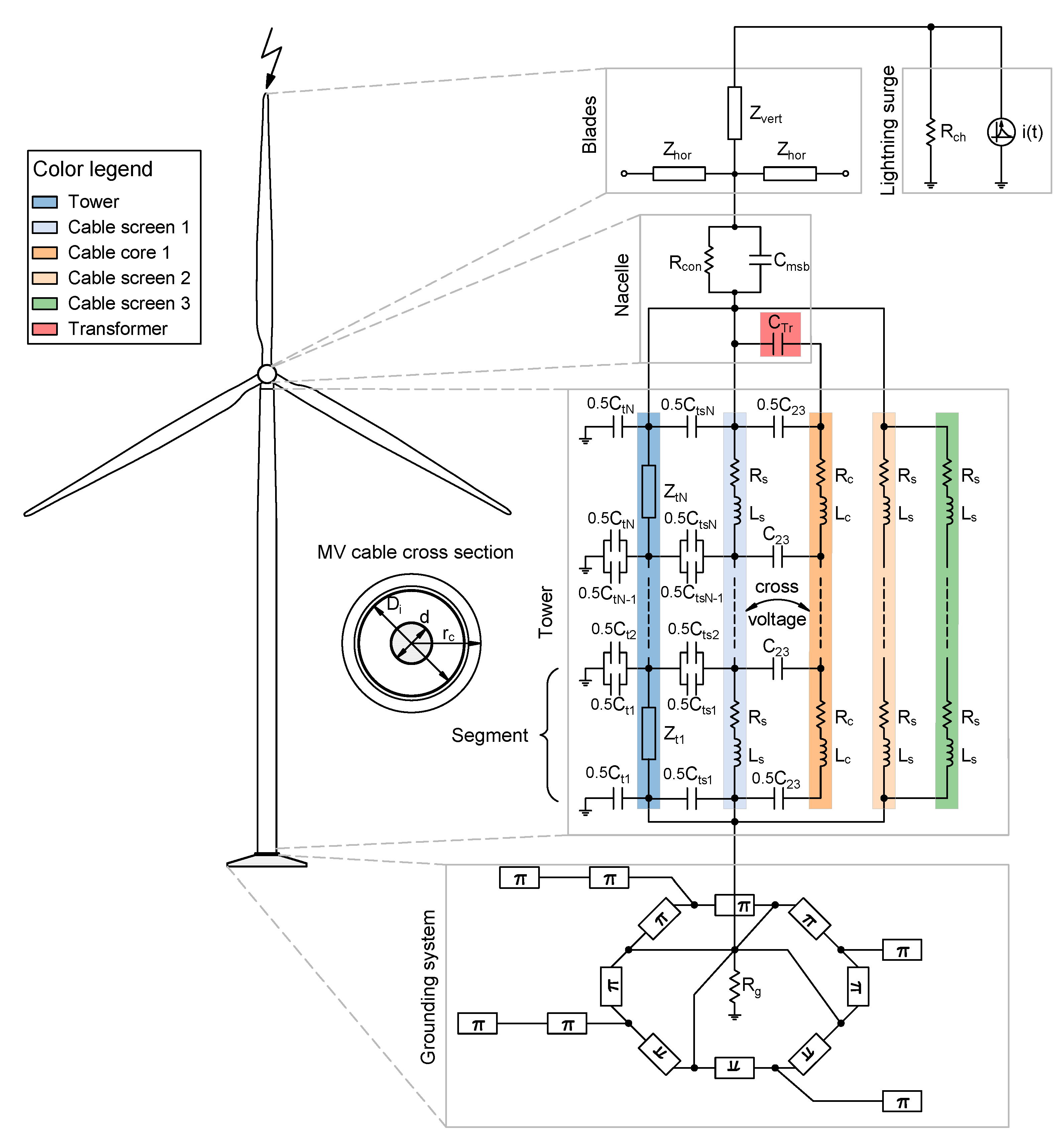
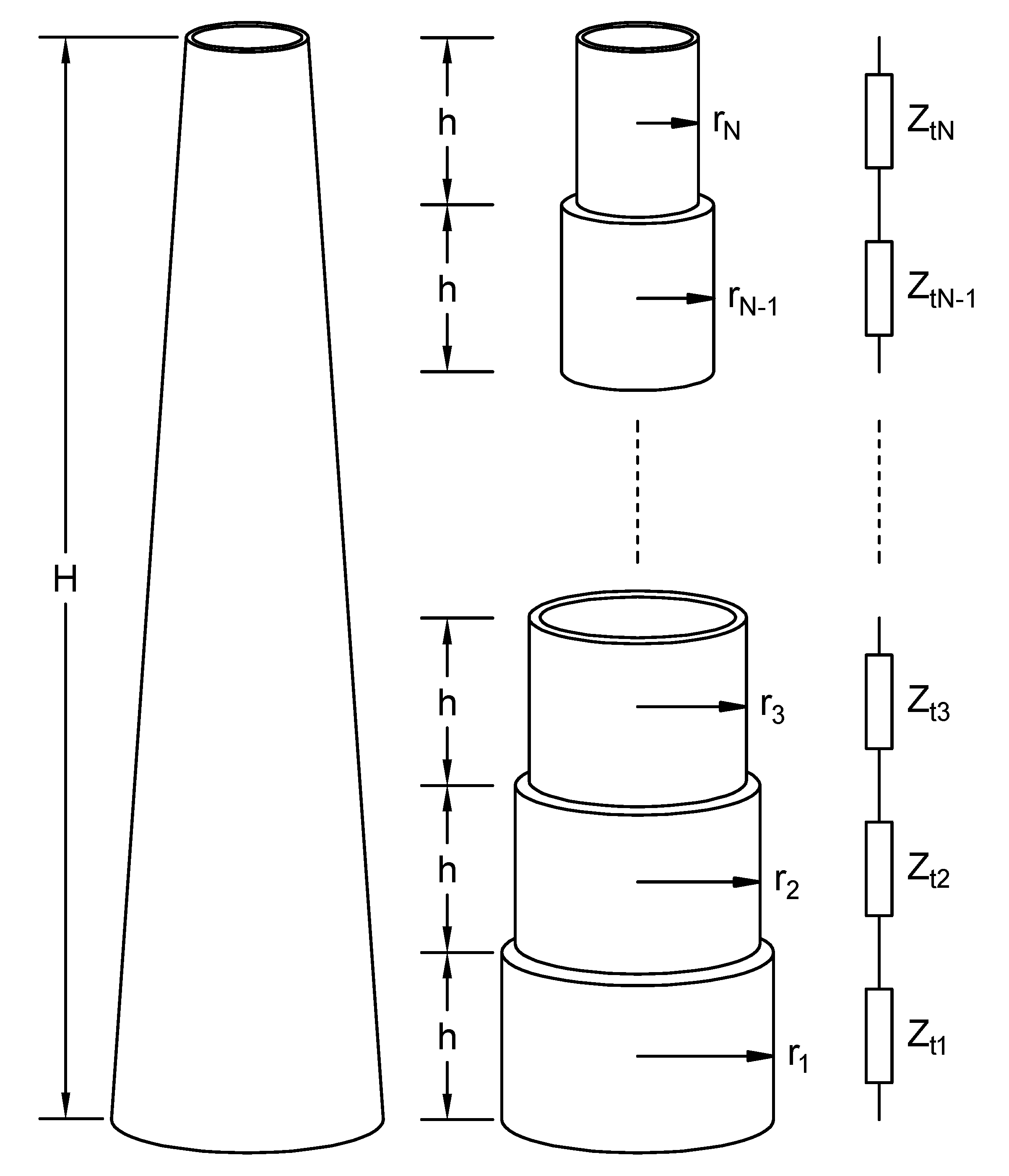
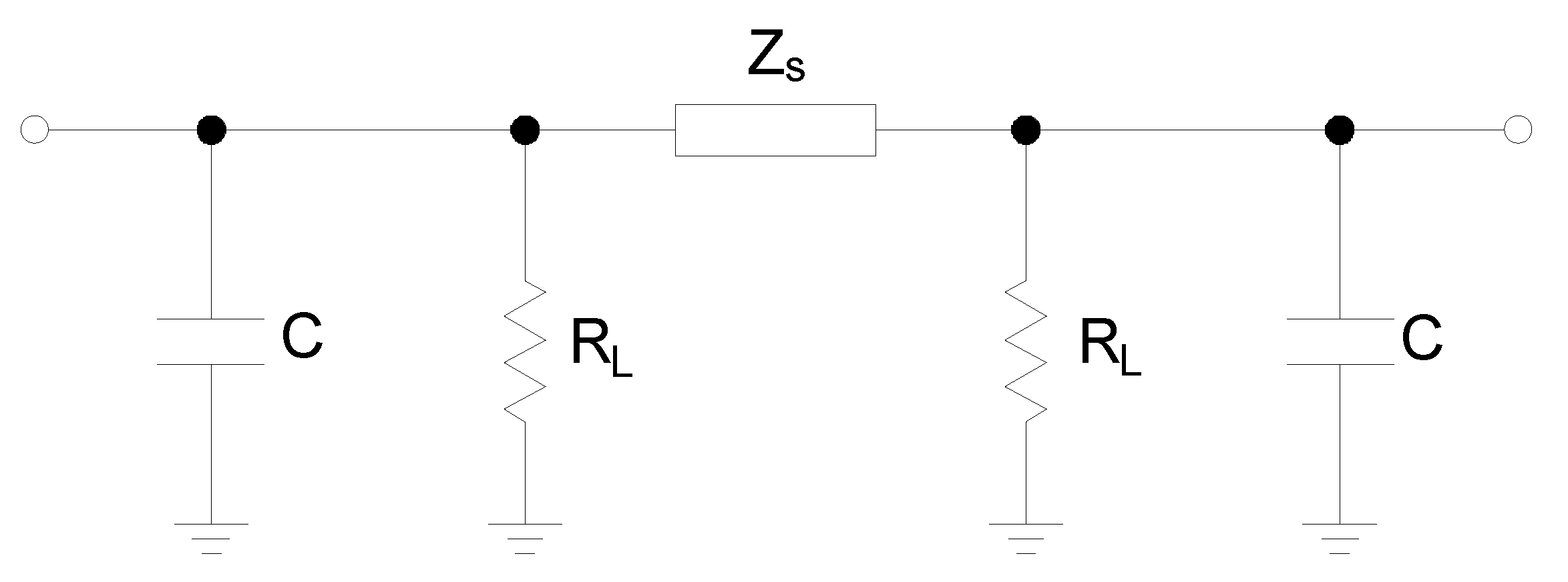
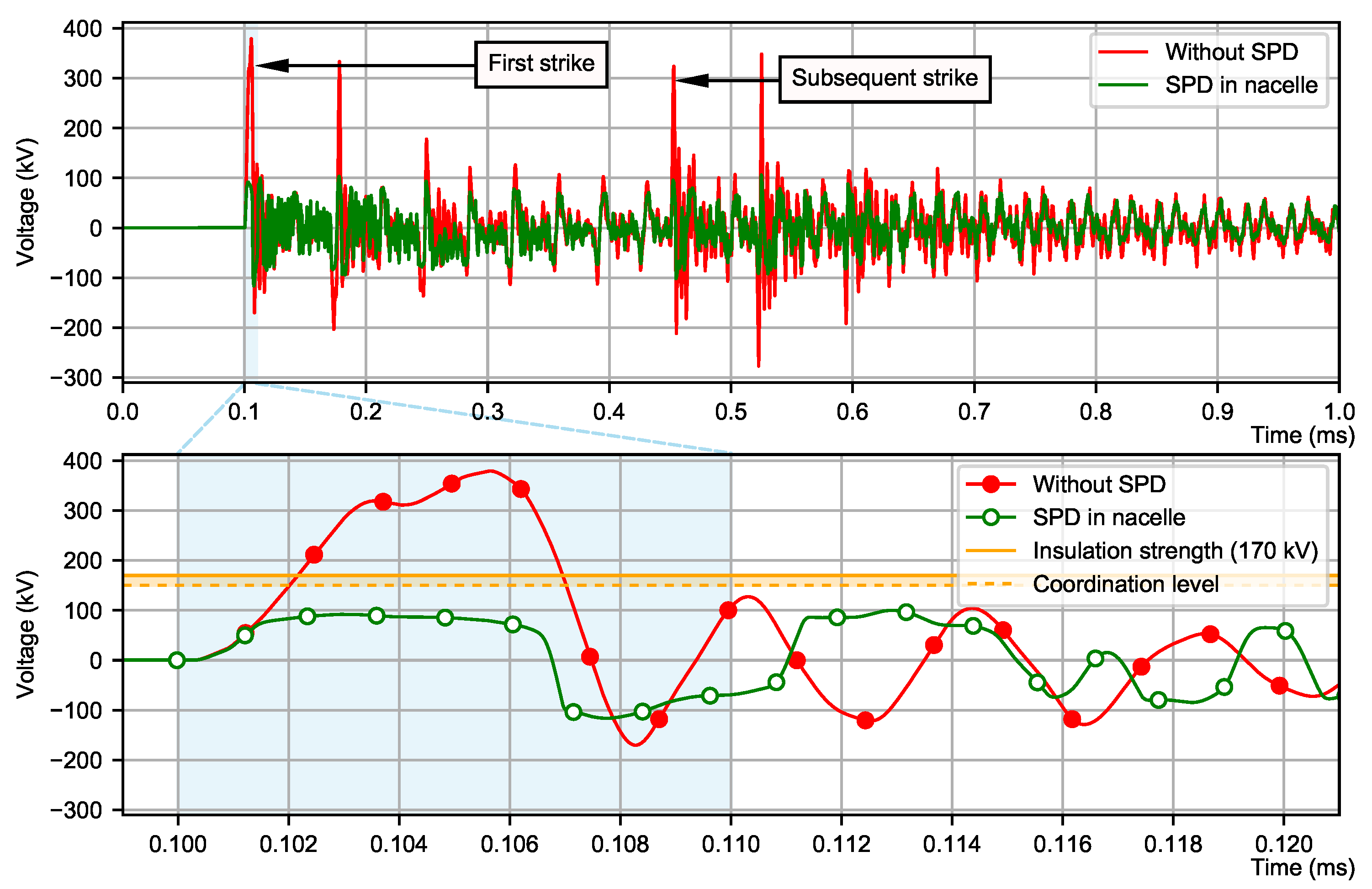
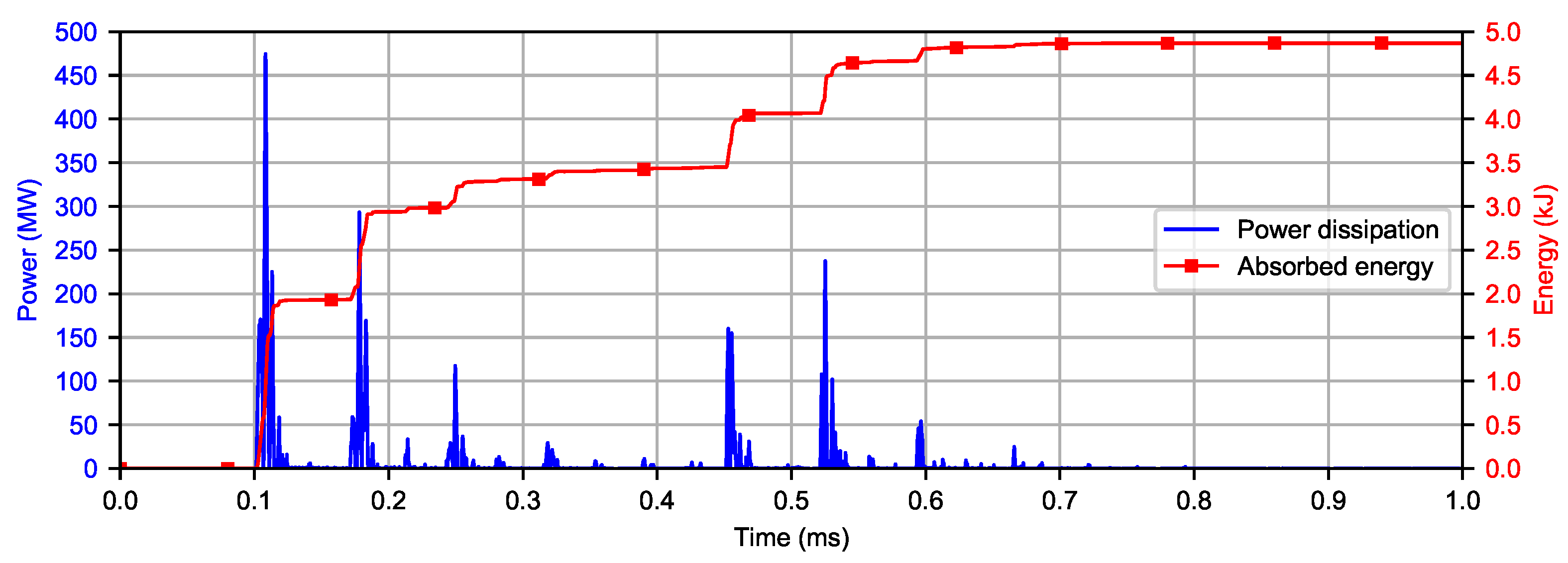
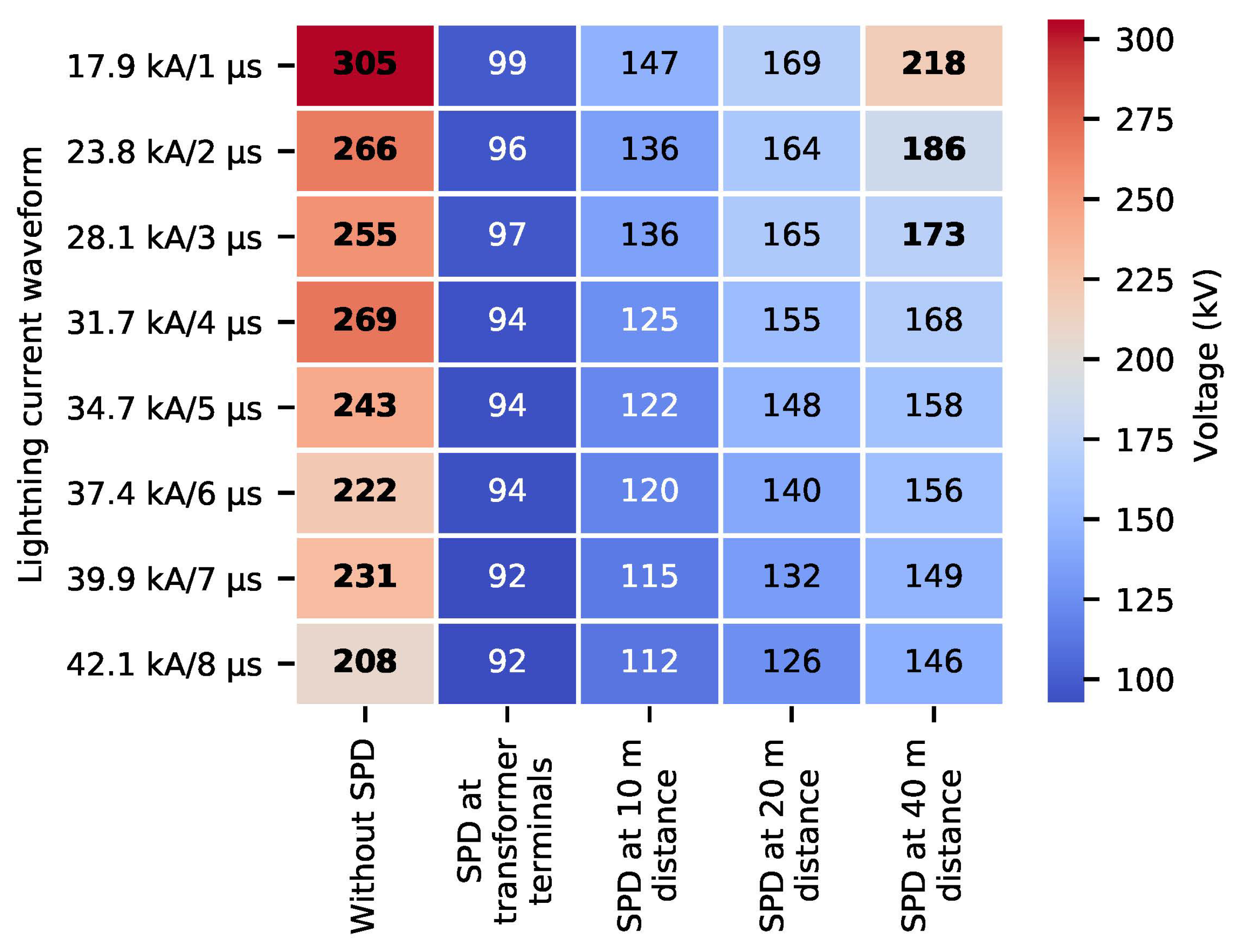
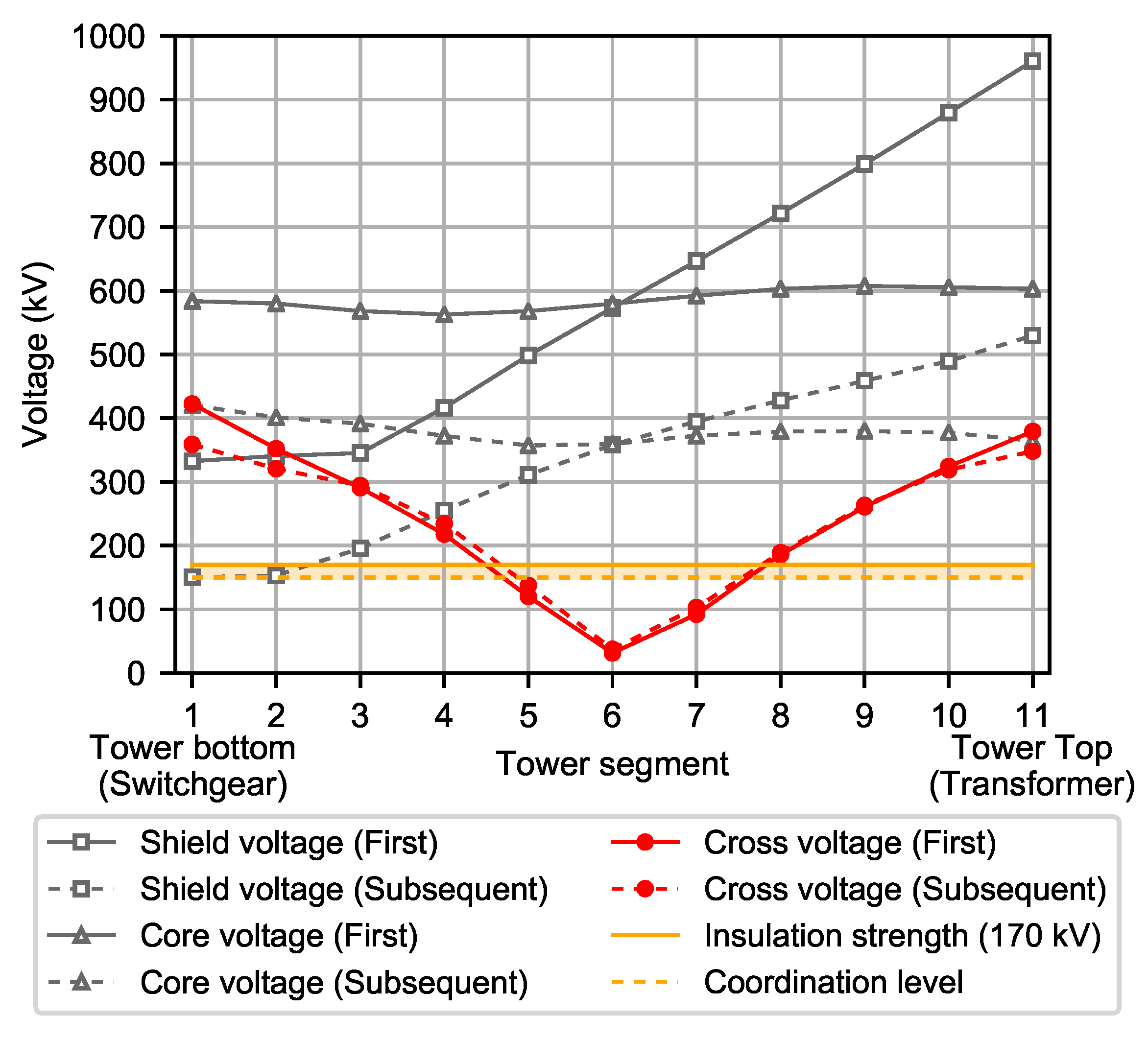
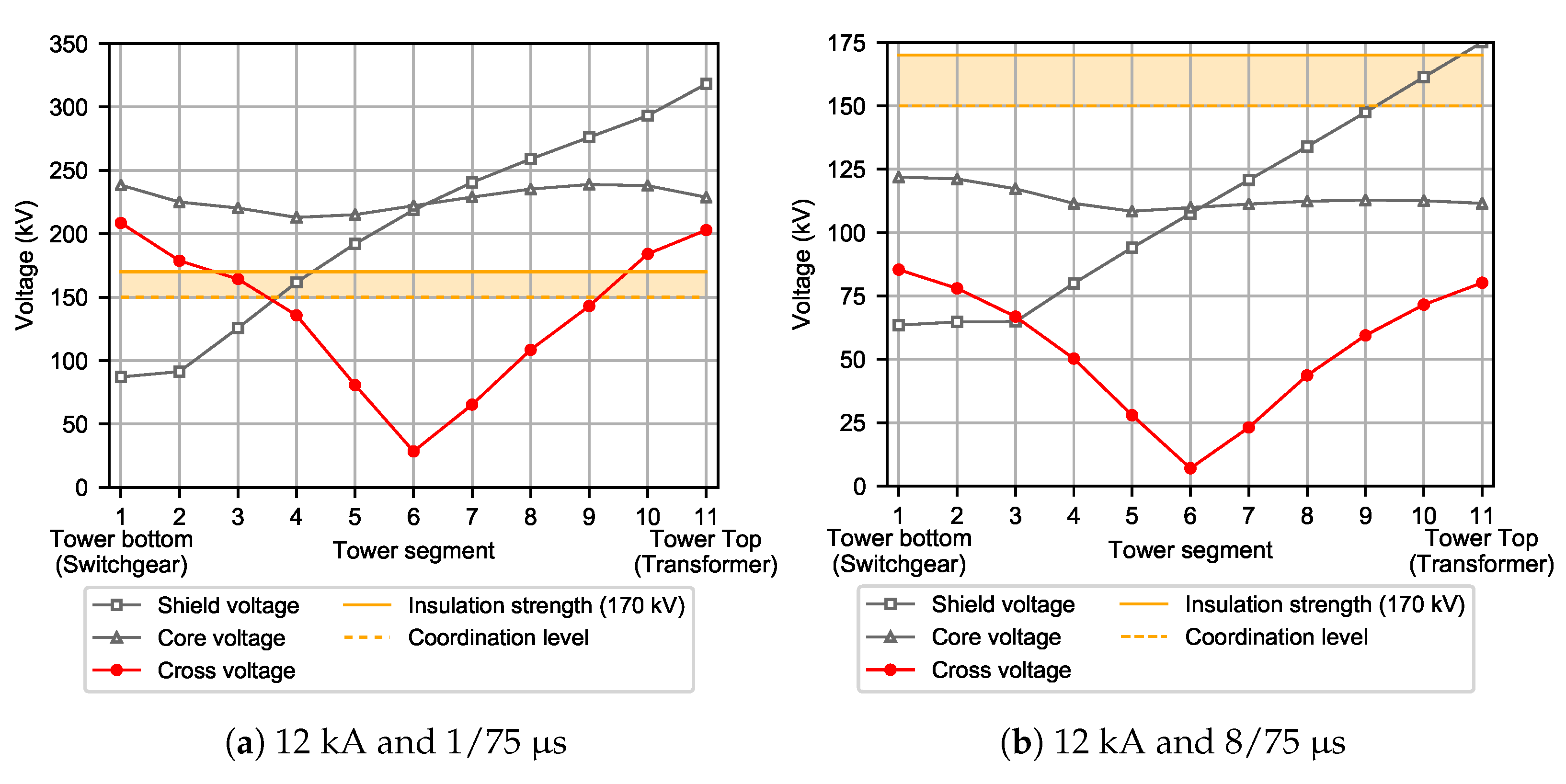
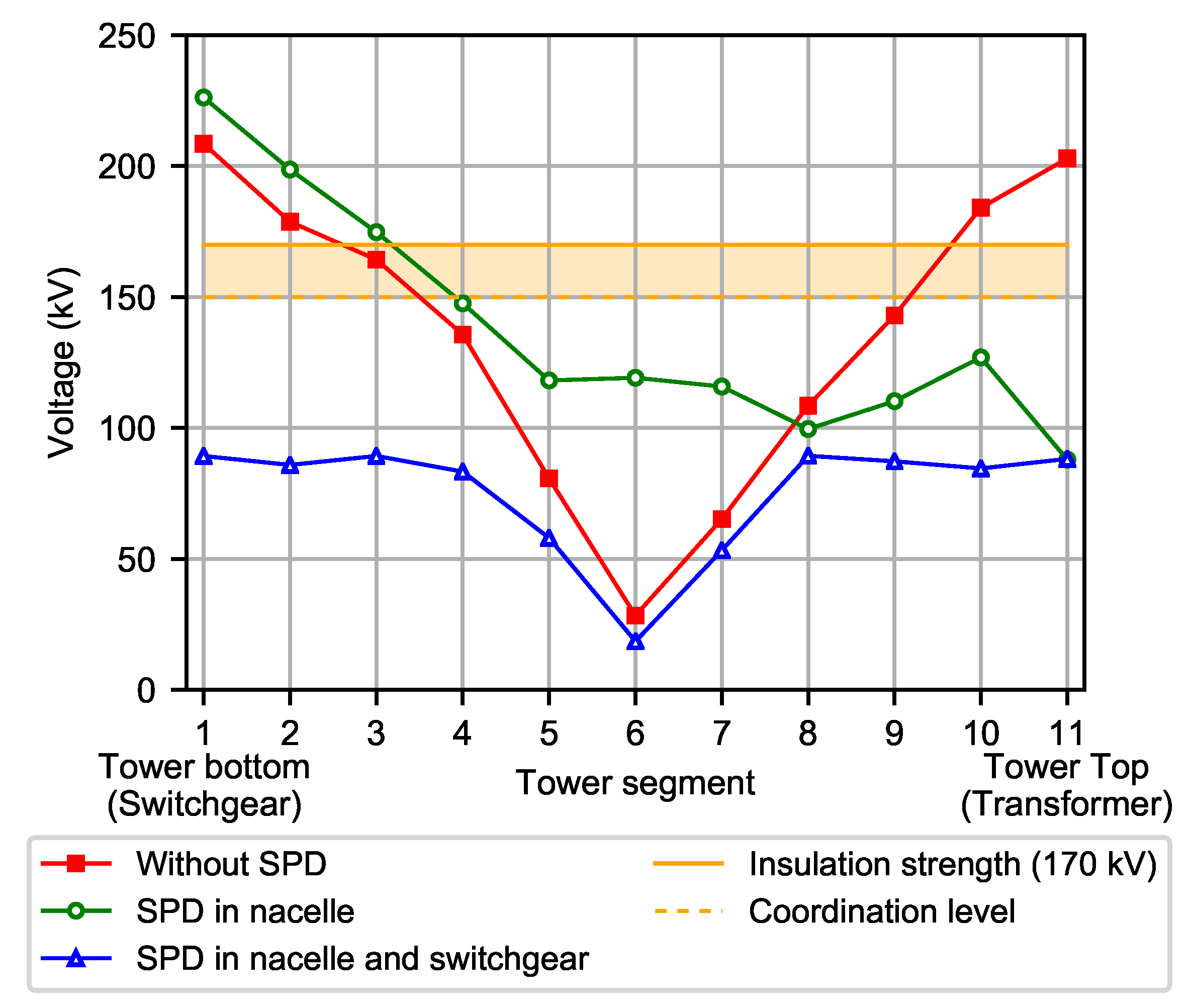
| Parameter | Unit | Value |
|---|---|---|
| Cable nominal voltages | (kV) | 36/30/18 |
| Core and screen cross section | (mm) | 70/16 |
| Conductor diameter | (mm) | 10.3 |
| Insulation thickness | (mm) | 8.0 |
| Sheath thickness | (mm) | 2.5 |
| Cable outer diameter | (mm) | 36.0 |
| SPD Location | Screen Grounding | Cross Voltage (kV) | ||||
|---|---|---|---|---|---|---|
| No SPD | Both ends | 208.5 | 135.7 | 28.4 | 108.5 | 202.9 |
| Top end | 811.5 | 89.5 | 111.9 | 104.2 | 143.4 | |
| Bottom end | 64.1 | 44.8 | 56.0 | 42.5 | 721.5 | |
| Nacelle | Both ends | 226.2 | 147.6 | 119.1 | 99.6 | 87.9 |
| Top end | 813.0 | 67.8 | 110.3 | 89.1 | 76.8 | |
| Bottom end | 682.7 | 670.1 | 711.5 | 660.3 | 109.2 | |
| Switchgear | Both ends | 87.8 | 92.3 | 122.4 | 134.3 | 207.6 |
| Top end | 110.4 | 650.8 | 696.4 | 690.4 | 670.6 | |
| Bottom end | 69.4 | 54.7 | 68.5 | 52.4 | 751.6 | |
| Nacelle and Switchgear | Both ends | 89.3 | 83.4 | 18.6 | 89.4 | 88.2 |
| Top end | 110.3 | 468.8 | 408.3 | 321.5 | 106.4 | |
| Bottom end | 104.1 | 315.5 | 392.9 | 456.6 | 106.1 | |
Publisher’s Note: MDPI stays neutral with regard to jurisdictional claims in published maps and institutional affiliations. |
© 2021 by the authors. Licensee MDPI, Basel, Switzerland. This article is an open access article distributed under the terms and conditions of the Creative Commons Attribution (CC BY) license (http://creativecommons.org/licenses/by/4.0/).
Share and Cite
Sarajcev, P.; Meglic, A.; Goic, R. Lightning Overvoltage Protection of Step-Up Transformer Inside a Nacelle of Onshore New-Generation Wind Turbines. Energies 2021, 14, 322. https://doi.org/10.3390/en14020322
Sarajcev P, Meglic A, Goic R. Lightning Overvoltage Protection of Step-Up Transformer Inside a Nacelle of Onshore New-Generation Wind Turbines. Energies. 2021; 14(2):322. https://doi.org/10.3390/en14020322
Chicago/Turabian StyleSarajcev, Petar, Antun Meglic, and Ranko Goic. 2021. "Lightning Overvoltage Protection of Step-Up Transformer Inside a Nacelle of Onshore New-Generation Wind Turbines" Energies 14, no. 2: 322. https://doi.org/10.3390/en14020322
APA StyleSarajcev, P., Meglic, A., & Goic, R. (2021). Lightning Overvoltage Protection of Step-Up Transformer Inside a Nacelle of Onshore New-Generation Wind Turbines. Energies, 14(2), 322. https://doi.org/10.3390/en14020322





